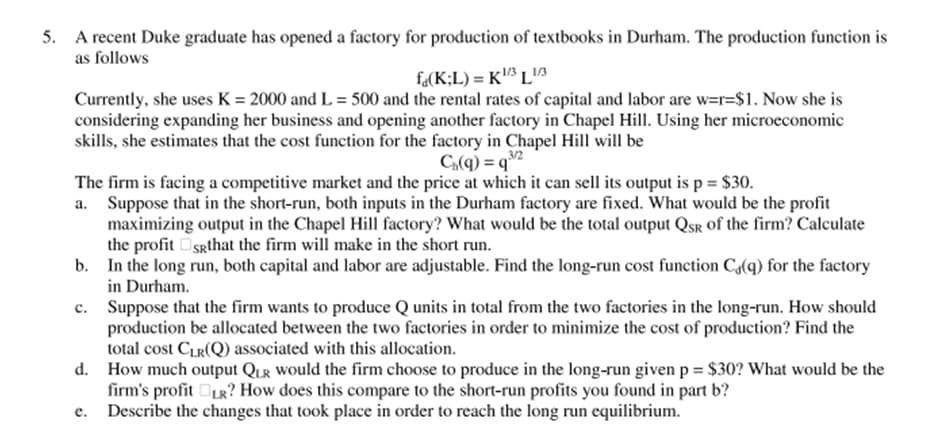5. A recent Duke graduate has opened a factory for production of textbooks in Durham. The production function is as follows f«(K;L) = K L1/3 Currently, she uses K = 2000 and L = 500 and the rental rates of capital and labor are w=r=$1. Now she is considering expanding her business and opening another factory in Chapel Hill. Using her microeconomic skills, she estimates that the cost function for the factory in Chapel Hill will be C(q) = q2 The firm is facing a competitive market and the price at which it can sell its output is p = $30. a. Suppose that in the short-run, both inputs in the Durham factory are fixed. What would be the profit maximizing output in the Chapel Hill factory? What would be the total output QsR of the firm? Calculate the profit SRthat the firm will make in the short run. b. In the long run, both capital and labor are adjustable. Find the long-run cost function C(q) for the factory in Durham. c. Suppose that the firm wants to produce Q units in total from the two factories in the long-run. How should production be allocated between the two factories in order to minimize the cost of production? Find the total cost CLR(Q) associated with this allocation.
5. A recent Duke graduate has opened a factory for production of textbooks in Durham. The production function is as follows f«(K;L) = K L1/3 Currently, she uses K = 2000 and L = 500 and the rental rates of capital and labor are w=r=$1. Now she is considering expanding her business and opening another factory in Chapel Hill. Using her microeconomic skills, she estimates that the cost function for the factory in Chapel Hill will be C(q) = q2 The firm is facing a competitive market and the price at which it can sell its output is p = $30. a. Suppose that in the short-run, both inputs in the Durham factory are fixed. What would be the profit maximizing output in the Chapel Hill factory? What would be the total output QsR of the firm? Calculate the profit SRthat the firm will make in the short run. b. In the long run, both capital and labor are adjustable. Find the long-run cost function C(q) for the factory in Durham. c. Suppose that the firm wants to produce Q units in total from the two factories in the long-run. How should production be allocated between the two factories in order to minimize the cost of production? Find the total cost CLR(Q) associated with this allocation.
Chapter11: Profit Maximization
Section: Chapter Questions
Problem 11.9P
Related questions
Question
100%

Transcribed Image Text:5. A recent Duke graduate has opened a factory for production of textbooks in Durham. The production function is
as follows
f«(K;L) = K³ L
Currently, she uses K = 2000 and L = 500 and the rental rates of capital and labor are w=r=$1. Now she is
considering expanding her business and opening another factory in Chapel Hill. Using her microeconomic
skills, she estimates that the cost function for the factory in Chapel Hill will be
3/2
C(q) = q°
The firm is facing a competitive market and the price at which it can sell its output is p = $30.
a. Suppose that in the short-run, both inputs in the Durham factory are fixed. What would be the profit
maximizing output in the Chapel Hill factory? What would be the total output QSR of the firm? Calculate
the profit Sgthat the firm will make in the short run.
b. In the long run, both capital and labor are adjustable. Find the long-run cost function Ca(q) for the factory
in Durham.
c. Suppose that the firm wants to produce Q units in total from the two factories in the long-run. How should
production be allocated between the two factories in order to minimize the cost of production? Find the
total cost CLR(Q) associated with this allocation.
d. How much output QuR Would the firm choose to produce in the long-run given p = $30? What would be the
firm's profit R? How does this compare to the short-run profits you found in part b?
Describe the changes that took place in order to reach the long run equilibrium.
е.
Expert Solution
This question has been solved!
Explore an expertly crafted, step-by-step solution for a thorough understanding of key concepts.
Step by step
Solved in 2 steps

Knowledge Booster
Learn more about
Need a deep-dive on the concept behind this application? Look no further. Learn more about this topic, economics and related others by exploring similar questions and additional content below.Recommended textbooks for you


Exploring Economics
Economics
ISBN:
9781544336329
Author:
Robert L. Sexton
Publisher:
SAGE Publications, Inc



Exploring Economics
Economics
ISBN:
9781544336329
Author:
Robert L. Sexton
Publisher:
SAGE Publications, Inc


Managerial Economics: Applications, Strategies an…
Economics
ISBN:
9781305506381
Author:
James R. McGuigan, R. Charles Moyer, Frederick H.deB. Harris
Publisher:
Cengage Learning

